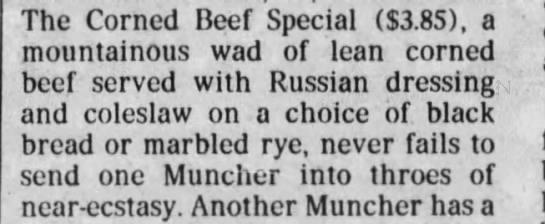It began with a Twitter post asking if you could go to a restaurant that no longer exists, which one would it be?
Memories of so many popped into my head. I asked my husband and we went on a trip down Memory Lane.
Our last time eating out would have been in early March or late February. I don't even remember. We do order delivery from a local restaurant every week just to give them business.
Neither my parents or my husband's folks took the family out to eat. In Tonawanda, NY, my folks couldn't afford to eat out. Dad ran the gas station his father had built. It supported our family and his mother. I remember sometimes going to a place down the road for a burger and fries where we sat on stools at a counter.
In 1963 my family moved to Royal Oak, Michigan. Mom's break from cooking came on Friday nights when we piled into the car and went down the road a mile to Peppy's Hamburgers in Clawson, where I live now.
 |
Peppy's Hamburgers in Clawson, MI
next door to Famous Chicken |
I was assigned the task of going into the restaurant and ordering the burgers and fries and drinks and bringing them back to my family. After eating in the car, we tossed the trash onto the parking lot. The burgers cost 15 cents. They came with catsup, mustard, relish, and chopped onions. My little brother only liked catsup so they had to make his burger special.
Sometimes Mom would pick up broasted chicken from Famous Chicken next door to Peppy's, just visible behind the Peppy's sign in the photo above.
At Adrian college my friends and I sometimes scraped together a few dollars and went into town to
Pizza Bucket. I am thrilled to say it's still there, serving brick oven baked pizza.
 |
At the Pizza Bucket in Adrian, MI.
I am on the left and my roommate is next to me. |
Early in our marriage we would literally save our pennies for the $1 repertoire movie theater in Delaware, OH, gong to a pizza place for dinner.
We moved to Philadelphia in 1975. During our fifteen years there the city was blooming with a restaurant renaissance.
Right after our move, we celebrated our third wedding anniversary at
Old Original Bookbinder's. I wore a long skirt and heels and looked very out of place. The dressier men wore denim leisure suits. We had lobster for the first time. We were given plastic bibs to wear. We also had clam chowder with lovely, big, crunchy oyster crackers. And cheesecake for dessert.
We first lived in Bucks County and ate at the local chain Seafood Shanty. We took my in-laws there for a special treat--their first lobster meal. My father-in-law's verdict was it wasn't worth the work to get the meat out.
Our first visit to New York City was to see Isaac Bashevis Singer's play
Yentl. We took the train to Grand Central Station and ate a bag lunch at Central Park before the show!
 |
the Reading Terminal building. It was a train station.
Below was the Reading Terminal Market. |
Before it closed, we went to Horn & Hardart on Broad Street to eat from the vending machines.
It was in Philly that we first ate the foods we came to love.
We had our first Tabouli at a restaurant counter in the Reading Terminal Market. I recently learned that the family that owns the Oasis Gourmet Cuisine in Royal Oak knows the family that ran that counter!
We had our first pesto at a bar/restaurant near Rittenhouse Square that had a pasta bar. You chose a pasta and a sauce: Alfredo, Marinara, or Pesto. We went to food festivals; we ate samosas sold on the street and small cups of a soup we learned was made with duck's blood.
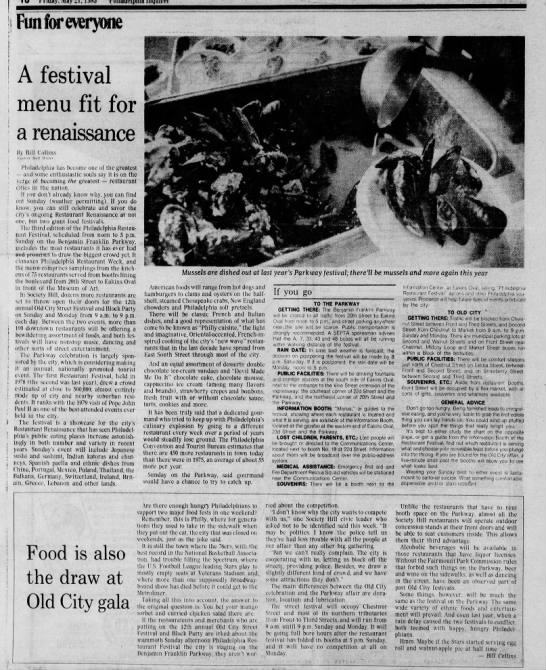
"In Society Hill, dozens more restaurants are set to throw open their doors lor the 12th annual Old City Street Festival and Block Party on Sunday and Monday from 9 a.m. to 9 p.m. each day....Almost all the Society Hill restaurants will operate outdoor concession stands at their front doors and will be able to seat customers inside. This allows them their third advantage. Alcoholic beverages will be available in those restaurants that have liquor licenses. Without the Fairmount Park Commission rules that forbid such things on the Parkway, beer and wine on the sidewalks, as well as dancing in the street, have been an observed part of past Old City festivals."
El Metate was located across from the Academy of Music. We liked to eat there after an afternoon concert. We liked the Chicken Mole.
Dickens' Inn, situated in New Market, was run by the author's great-grandson, Cedric Charles Dickens. We remember the green beans were still crisp. We had grown up with canned, mushy vegetables.
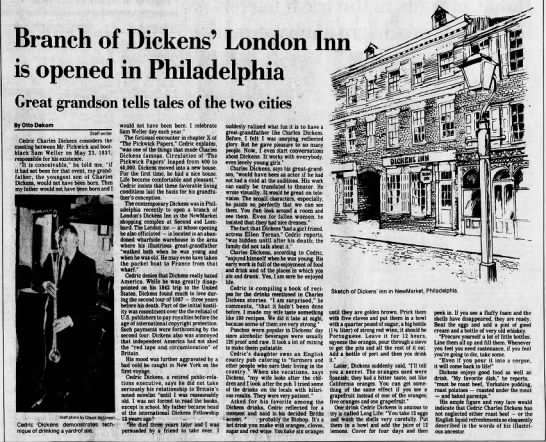
The Monk's Inn was on Second Street along the Delaware River where we feasted on steamed mussels.
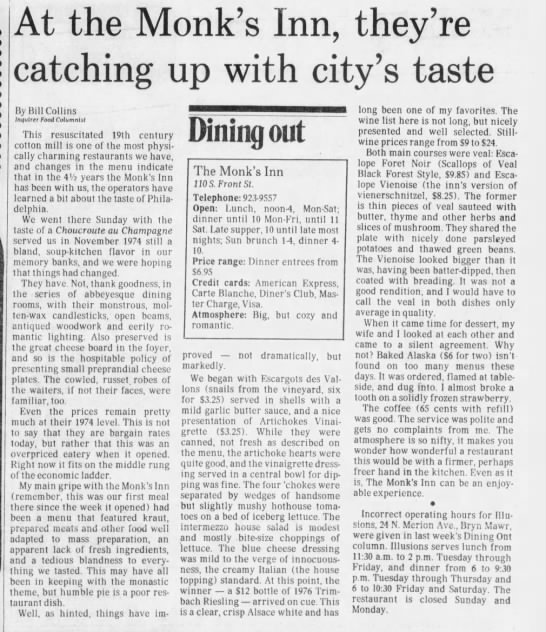
Once Upon a Porch on Head House Square in Old Town was a favorite place for ice cream sundaes. I liked the Gibson Girl--vanilla ice cream with caramel topping and peanuts. The perimeter of the seating area was comprised of 'porches'.
We went to Eden Restaurant for burgers with alfalfa sprouts. The owner also ran the upscale Frog restaurant which we went to once. Le Bec Fin was way out of our price range, but we dined there one. My husband ordered steak tartare.
When we lived in Kensington, we would go to a pizza place in Port Richmond, Philadelphia, that made pizzas in a wood oven and a bakery where I always got Hamentashen. And on Allegheny Avenue we went to a Chinese restaurant for the fresh handmade egg rolls.
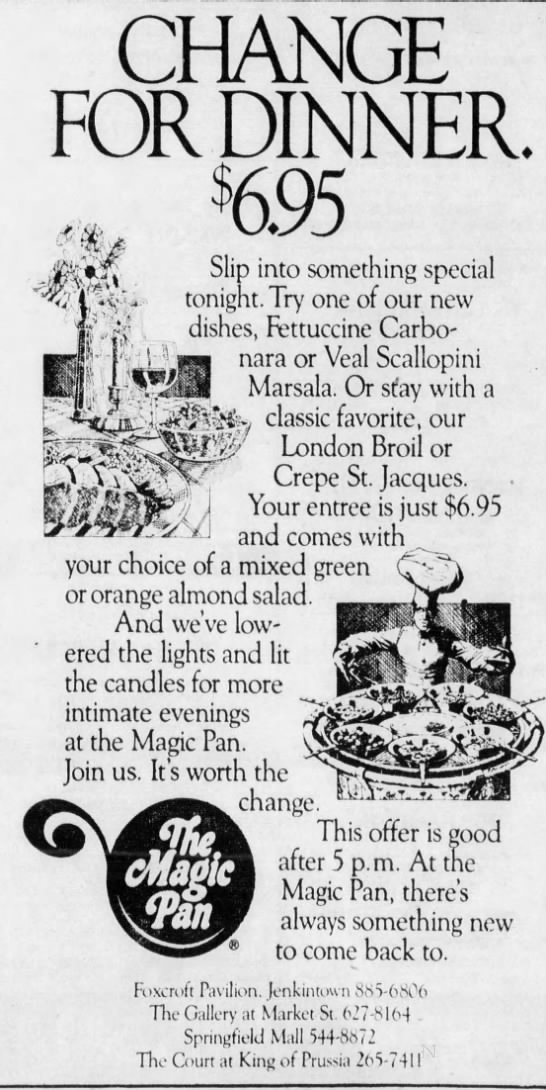
The Magic Pan in The Gallery mall had a lovely split pea soup served with a dash of sherry and a spinach salad with mandarin oranges and almonds.
We loved the ambience of the
City Tavern, reopened for the Bicentennial.
Dining was always fun on the Moshulu, a ship docked on the Delaware River. I had eaten Oyster Rockefeller but was very naive about food. I ordered oysters and when they came raw, I was shocked. I had one and my husband ate the rest.
We went to Old Town and ate at the Middle East Restaurant which had a belly dancer, finishing off with the small cup of strong coffee.
One year for my July birthday we went to Fish & Company and I had an amazing poached salmon with dill sauce.
One day after walking Philadelphia from river to river and back again we stopped at Rib-It and my husband ordered the all you can eat ribs. He ate two servings!
For lunch in Center City we loved Saladalley's huge salad bar and Bread & Co. where we ordered soup and a basket of delicious breads. I went with coworkers to lunch at Corned Beef Academy for the thick sandwiches with Russian dressing and coleslaw.
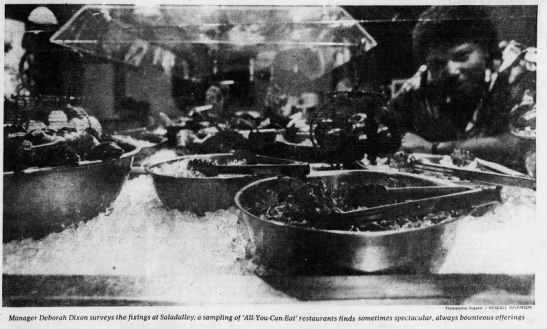 |
| Saladalley |
Once when my brother visited us in Philadelphia we took him to dinner at Cafe Nola on South Street. Our bill came to $100. That was a very expensive evening out!
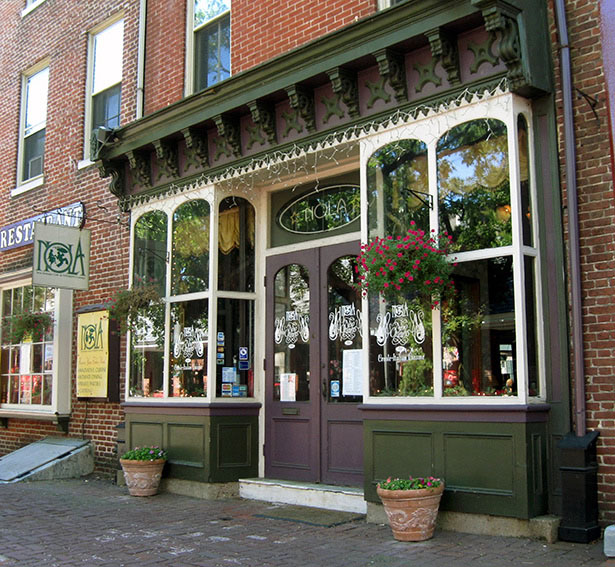
We loved to go to
Chinatown for the food. I would stop at a shop and buy the simple black Chinese slippers that I wore in summer.
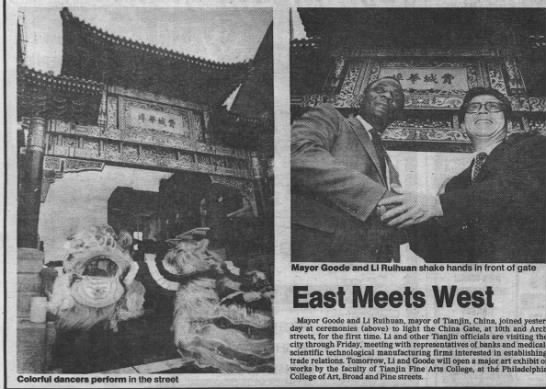
When the
China Gate opened in 1984 my husband was working for a charitable trust company and got tickets to the opening day banquet. Most memorable was the delicious sweet and sour bass, cooked whole. We went to the opening ceremony pictured in the news clipping above.
Our son was born in 1987. Having a child was expensive and we no longer frequented the Center City restaurants. As a toddler his favorite restaurant was Roy Rogers. We ate at an Italian place in downtown Olney with live music or ate at the Oak Lane Diner on Broad Street, a few blocks from where we were living. After church on Sundays we would eat at Friendly's or the Taco Bar at Wendy's.
 |
| The Oak Lane Diner in recent years |
We left Philly in 1990. We lived in a small town with few restaurants. But we liked The Wedge in downtown Hillsdale where we lunched on a vegetarian wrap.
In Lansing we enjoyed more options, including national and local chains. Our favorite place was a small Middle Eastern restaurant not far from the shopping mall. The owner told us he had run a big construction company in Iraq. When his son, who was studying in America, came down with cancer, he sold his business and used the money to pay his medical expenses. The son was studying to be a doctor. And now his dad ran a restaurant. After we moved, we always stopped in when driving across state, until one day we found it was closed.
Some of our regular places closed during the last recession, including Troy's Anita's Kitchen. When we came to town we always ate there. The waitress would greet us with a cup of lentil soup. She knew we always ordered it!
We have been ordering delivery from local restaurants during lockdown. Our small city has some of the best. I pray they survive. I don't want to add them to this list.
















